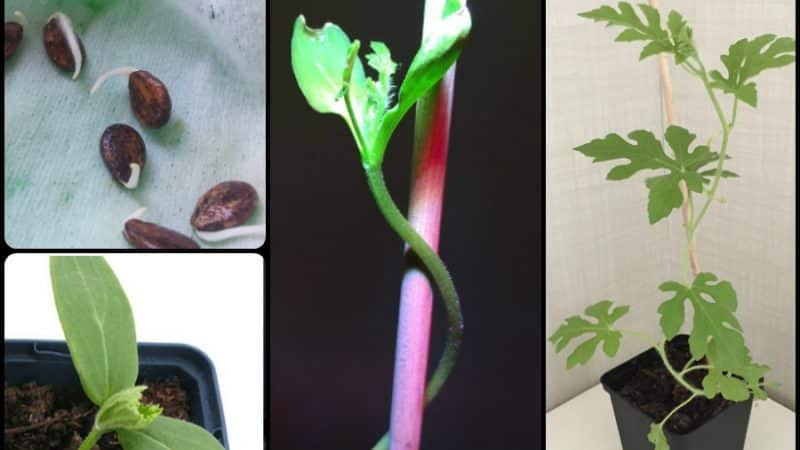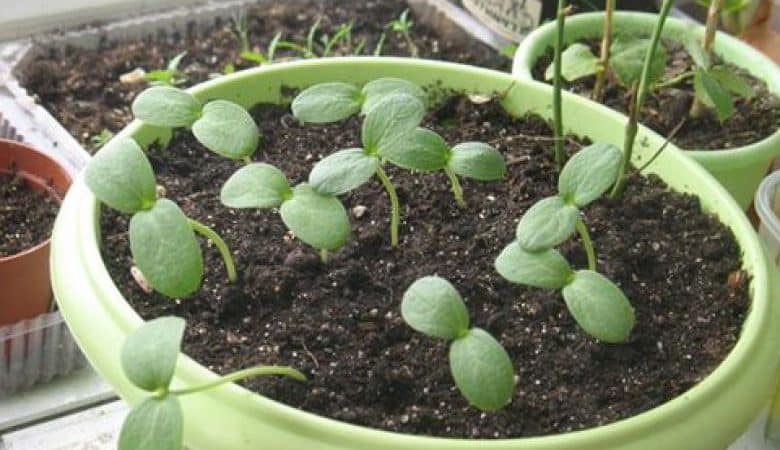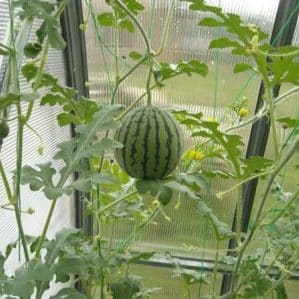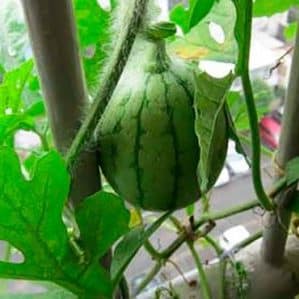How to grow a watermelon at home from a seed: step-by-step instructions
Most people love watermelons, but not everyone has a plot of land where they can plant this crop. However, for true lovers of fresh and aromatic fruits, this will not be an obstacle - after all, watermelons can be cultivated at home.
From the article you will learn how to grow a watermelon at home and how to care for it in order to get a harvest.
Is it possible to grow watermelons at home from seeds?
Increasingly, garden and field crops are taking root on apartment windowsills. Usually peppers, cucumbers and tomatoes are planted in pots, and such an exotic fruit as watermelon is chosen only by the most daring plant growers. But caring for this berry is not as difficult as it seems, and the taste of the homemade fruit is not inferior to melon specimens.

What varieties are suitable for this?
Watermelon is a crop that is sensitive to heat and light. It is easy to maintain a high temperature in a heated apartment, but providing the plant with enough light in autumn and winter is problematic. Therefore, give preference varieties, which bear fruit in short daylight conditions. The timing of ripening is also important. It is better to plant early varieties at home; in this case, the harvest will be harvested within three months.
The following varieties of watermelons are grown on a windowsill or covered loggia:
- Gift to the sun;
- Volgar;
- Rose of the Southeast;
- Ogonyok;
- Stokes;
- Siberian.
Necessary conditions for growing watermelon at home
If you do not provide the melon crop with a comfortable climate and care, you may not expect fruit. Growing watermelons indoors has its own characteristics that are important to consider.
Place
The watermelon will feel best on the southern windows, but the northern side is not at all suitable for it. In rooms facing east or west, it will also be possible to grow this exotic crop.
Watermelon does not like cold and drafts. You can place it on the windowsill, under which there is a central heating radiator.
Attention! If planned plant a crop on the balcony, it is important to create additional heating.
Tara
Watermelon seedlings are grown in plastic cups, small pots or special cassettes. A stronger sprout will need a larger container. A bucket, basin or other container with a volume of at least 10 liters will do. You can independently put together a box 50*50*30 cm from wooden boards.
Plant seeds It is not advisable to immediately put it into large containers, because water often stagnates in a large clod of earth, and the plants may die. If you don’t want to bother with seedling cassettes, watering will have to be carefully controlled.

The soil
Loose, nutritious soil is prepared in advance. It is made from equal parts of humus, turf and sand, with a little ash added. Before planting, the soil is disinfected by scalding it with boiled water.
Light and temperature
The plant needs a 12-hour daylight hours, so during cloudy periods it will require additional lighting sources: LED, fluorescent or phytolamps.
Important! During the period of ovary formation, the plant should not be overcooled. The optimal temperature regime, which must be regularly monitored, is +25...+30°C during the day and +18°C at night.
Preparatory stage
First of all, planting material is sorted. Small and damaged seeds are thrown away, large ones are filled with salt water prepared at the rate of 5 g of table salt per 100 g of liquid. Seeds that have sunk to the bottom are considered suitable for planting. They are taken out, washed with clean water and dried.
After this, gauze is moistened with a solution prepared from 0.5 g of humate and 1 liter of water, the seeds are wrapped in it and kept there until germination.
Landing
Seeds with hatched sprouts are planted in plastic cups filled with lightly compacted earth - 4-5 pieces each. in each. Make sure that the soil always remains moist and the air temperature is about +25°C. If these conditions are met, shoots will appear in 7 days.
After 2-3 weeks, when the seedlings have grown a little, it is necessary to pull out some of the sprouts, leaving one of the strongest seedlings in each container. After a month, the plants are moved to a permanent place along with a lump of earth.
Growing in a pot and care

After transplanting the crop into spacious pots, its root system begins to develop rapidly. Pinch the third or fourth leaf, giving the side branches a vertical or horizontal direction. You can also leave just one lash. In this case, the harvest will be obtained faster.
When the flowers bloom, perform artificial pollination. Without this procedure there will be no fruit. Using a soft brush, transfer pollen from a male flower with a thin stalk and stamens to a female flower with a thick stalk and pistil. The beginning of berry growth is signaled by an increase in the size of the female stalk. If the whip with the ovary is in a vertical position, it must be secured to avoid breakage.
Attention! You should not leave more than two fruits on one bush, otherwise they will not have enough nutrition.
Watering
Water liberally, but rarely (once a week) so that the soil does not turn sour. If the soil is waterlogged, the taste of the fruit will deteriorate. Experts recommend limiting the water supply after the berries begin to ripen. It is believed that a slight moisture deficiency makes watermelons sweeter.
Feeding
The plant begins to be fed after the formation of three large leaf blades. First, the watermelon is watered with water, and then with a solution of complex fertilizer. At this stage, preparations with equal contents of potassium, nitrogen and phosphorus or with a slight predominance of nitrogen are suitable.
The second fertilizing with potassium and phosphorus fertilizers is carried out during the formation of the ovaries. After 2-3 weeks, the procedure is repeated a third time.
Diseases and pests
Watermelons are susceptible to a number of diseases, which especially often develop due to errors in care. When growing crops at home, the following pathologies are common:
- Fusarium wilt – a fungal disease that leads to intoxication and death of the plant. For preventative purposes, the soil is disinfected and dried lashes are removed in a timely manner.

- Anthracnose – Occurs with high air humidity. The rind of the watermelon becomes covered with yellow spots, which merge with each other over time. Keep equipment clean, disinfect the soil, and treat planting material with Fundazol.
- Root rot – occurs when overwatering. The disease destroys the root system and appears as black-brown spots on the lower part of the stem. Copper sulfate and wood ash are used for treatment in the initial stages. In advanced cases, the diseased plant is destroyed.
- Powdery mildew – develops when the soil is infected with a fungus. The leaf blades become covered with white spots, the berries become deformed and become tasteless. Powdery mildew is combated using a 25% karatan solution.
- Bacterial spot – first the spots appear on the leaves, and then on the peel of the fruit. There is no effective drug against this disease yet, so the affected parts of the crop are cut off.
Pests enter the pot from the street or from untreated soil. Watermelon is damaged by the following insects:
- melon aphid;
- germ fly larvae;
- spider mite;
- wireworm;
- thrips;
- root-knot nematode;
- cutworm butterflies;
- locusts
To get rid of pests, plants are sprayed with chemicals (BI-58, Fitoverm, etc.). Among the folk remedies, an infusion of wormwood, a solution of wood ash and laundry soap, as well as a chamomile decoction are effective.
Harvesting

When the fruit ripens, its stalk dries out and the rind becomes glossy and smooth. Checking the ripeness of a watermelon, lightly flicking it with your fingers. If it is ripe, the sound will be dull and deep.
The weight of home-grown berries usually does not exceed 600-800 g. If the plant has enough light, watermelons will be as sweet and tasty as fruits brought from the south.
Conclusion
Anyone can grow a watermelon at home from a seed. To do this, the plant is provided with a comfortable temperature, the right amount of light and proper care.
If these conditions are met, sugar watermelons will ripen on your windowsill, in no way inferior to those from the south.